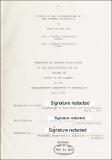Vitamin A and glycoproteins of rat corneal epithelium
Author(s)
Yang, Cha Lee Kim.
Download1376530012-MIT.pdf (27.04Mb)
Other Contributors
Massachusetts Institute of Technology. Department of Nutrition and Food Science.
Terms of use
Metadata
Show full item recordAbstract
Previous work from this laboratory has shown that the uptake of labeled precursors into a single specific glycopeptide in the rat intestinal mucosa was depressed significantly in vitamin A deficiency (De Luca et al ., 1970). A very similar pattern to the intestinal glycopeptide pattern was obtained from the rat corneal epithelium; namely, the glycopeptide affected by vitamin A was eluted with 0.4 N LiCl solution by a stepwise column chromatography on DEAE-Sephadex A-50. A specific "peak S" glycopeptide eluted between 0.35 N and 0.42 N LiCl solution was found to be the most decreased (approximately by 50%) glycopeptide component by vitamin A deficiency when a new continuous gradient column chromatography of the same anion exchanger was employed. "Peak S" glycopeptide was further characterized by polyacrylamide (7.5%) gel electrophoresis and gas-liquid chromatography. The affected "peak S" glycopeptide was found to be rich in sialic acid, possibly as an end-sugar. Topical application for one hour in vivo of water-dispersible vitamin A palmitate to corneas of deficient rats resulted in a stimulation of glycoprotein/glycopeptide synthesis upon subsequent incubation in vitro. Upon fractionation of glycopeptide prepared from vitamin A-deficient control and deficient, vitamin A-treated rat corneal epithelium by DEAE-Sephadex A-50 column chromatography, the fraction eluted in 0.2 N LiCl solution showed a marked increase in labeling of 14c-glucosamine into glycopeptides. This stimulated fraction appears to consist of small molecules probably lacking sialic acid. The in vitro stimulation of glycopeptide synthesis in vitamin A-deficient corneal epithelium seems to be confined also to the 0.2 N LiCl fraction. Histologically, corneal epithelium, and particularly the mucus-secreting conjunctival gland showed a strong fluorescent response to fluorescent antibody made against the intestinal glycopeptide affected by vitamin A.
Description
Thesis: Ph. D., Massachusetts Institute of Technology, Department of Nutrition and Food Science, 1973 Cataloged from PDF of print version of thesis. Vita. Includes bibliographical references (pages 174-184).
Date issued
1973Department
Massachusetts Institute of Technology. Department of Nutrition and Food SciencePublisher
Massachusetts Institute of Technology
Keywords
Nutrition and Food Science.